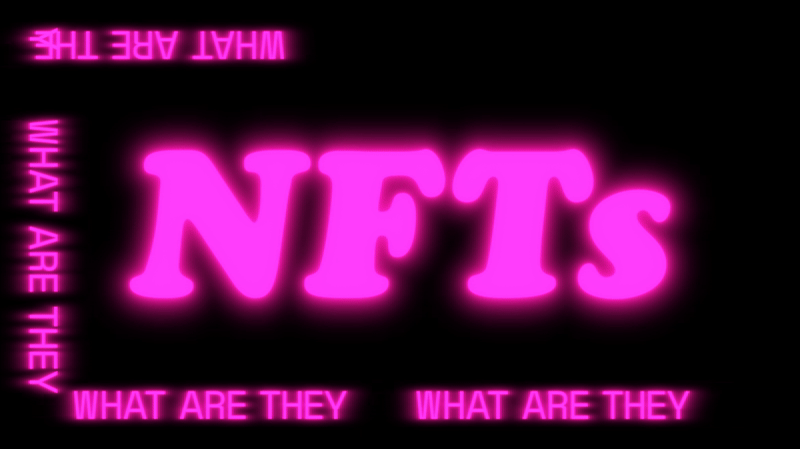What the hell is an NFT?

First things first:
What are NFTs (Non-fungible Tokens)?
If you asked my uncle, he'd laugh and say, "What, those pictures from the internet all the millennials are throwing away their money on? You might as well light money on fire!"
This was a real conversation that happened during Christmas this year. All I could do was stand there and smile.

He has no idea that:
- NFTs are way more than images.
- They have an endless amount of utility.
- They are the future of digital ownership and authenticity.
- All digital assets will eventually exist as NFTs.
(And just because Paris Hilton, Eminem, and Steve Aoki own Bored Apes doesn't mean NFTs are just a rich-people fad, either.)

Working backward:
- A token
- That isn’t fungible (def: interchangeable with an identical item)
In other words, unique tokens that live on a blockchain.
The first part of that statement is pretty important. NFTs are unique, meaning one does not equal the other in the way dollars or bitcoins do. That’s what non-fungible means.
Think of an NFT as a virtual trading card — one that also exists as an asset in crypto.

The second part of that statement is equally important. To live on a blockchain is to live on a digital ledger verified by all computers that cannot be disputed or changed. It is a single, decentralized source of truth.
NFTs are inextricably linked to the blockchain, which means they are built on a future of trust and decentralization.

They're very young — we're pioneering future utility of NFTs as we speak.
They represent ownership of digital assets, and they have fantastic metadata.
NFTs are more than just JPEGs of monkeys and pixelated punks.
(We call those Avatar or PFP (Profile Picture) projects, by the way. They are often used as Profile Pictures by those who own one — a status-symbol of sorts, or proud badge of community membership.)

If you engage in the NFT space on social media, you’ve probably seen a lot of these. It’s some sort of character in a square and it’s selling for thousands of dollars — and you probably want to know why.
The answer is simple: People love collecting. Think of it like baseball cards, Pokemon, or Beanie Babies. Some are rarer than others. They’re an addicting rabbit hole for those who enjoy games and/or collecting anything.
You’re likely in the middle of a shill storm on a daily basis consisting of person after person trying to convince you their project rocks friggin' socks and why you should spend $900 on their poorly drawn bird. If I’m being fair, a lot of these projects do have some deep roots in storytelling and are genius methods of forming communities (NFTs lend themselves well to that ability—more on that later.)
Unfortunately, we’re not currently encouraging long term holding in the space. 90% of projects won’t survive, according to Digital Transformation expert Swan Sit. Call me crazy, but I have a hunch that is because the majority of these projects don’t offer a collector external value (with the exception of bragging rights in select cases).
So then, why are PFP projects so popular in the NFT space? Well for one, they’re status-symbols in the crypto community. It’s impressive to own a Bored Ape, due to their luxury price and affiliations. Secondly, many of these projects (at least the ones that last) form real communities, having a discord attached to them, exclusive parties that can only be attended by community members (holders of that NFT), or in some cases a game (like Divine Dragons, which is dropping very soon!).
NFTs are digital ownership.
Social media and NFTs are inextricably linked. Right now, social platforms own all of your content. Aside from a website, which is an owned digital property for brands. There is nothing that helps easily give content creators indisputable credibility of their work. It’s the wild west right now. Let’s be civilized.
Instead of Big Tech owning our content and our data (shoutout to all of the creators who’ve been shadowbanned from TikTok), creators have full autonomy of their content.
You can think of NFTs like Certificates of Ownership. If the NFT exists in your wallet, you are the indisputable owner of said NFT. You may do what you want with it — nobody is going to take it away from you or tell you it isn't yours.

Individual's wallets are public and accessible by anyone with internet access. Because of this complete transparency, the authenticity of an NFT is always verifiable.
Rachel Wolchin is an author whose work was always reshared on Tumblr without credit. NFTs are a way to collect all of those external shares and link them back to Rachel. If every piece of content Rachel published was also minted on the blockchain, she would never have to worry about loss of credit again. NFTs allow us to truly own our content.
“I got famous on Tumblr and Pinterest, and a lot of the things I was saying were being circulated and people were sharing them as if they were their own thoughts. With NFTs… I don’t need to worry about if someone shares something on the blockchain — it says it's mine when it's mine.” —Rachel Wolchin @ NFT.NYC
NFTs are the gateway to Web3.
There are three eras in the history of the internet (Think of them as “generations”.)

In other words, Web 1 was "read only", Web 2 is "read & create", Web 3 is "read, create & own".
The most important part about Web3 is the decentralization of the internet. Torrents, crypto, IPFS, and new forms of DNS like ENS and Unstoppable Domains all exist under the web3 umbrella.
I define web3 as the trustless web — a world that empowers us to make independent financial decisions without ever needing to “take anyone’s word for it”. Everything is provable. I don't have to trust a brand to send my money for me. I don't have to trust a vendor’s word that that file is what they say it is. I don't have to trust big tech not to lose, use, or sell my data. It's all distributed, code based, and free from middlemen.
As DCinvestor, a Twitter-famous NFT collector and avid DeFi supporter, once said:
“The value of the Ethereum isn’t that it’s a global cloud computer… rather it is a general purpose, shared source of truth which everyone can agree on, while remaining censorship-resistant and tamper-free with no one “controlling” it.”
I'm a big proponent of using NFTs and blockchain technology to improve authorship and opportunity for both artists and brands.
This is not a trend. This is a real solution to issues the internet economy has been facing for a long time — and you don't want to miss out!
So now that you know what NFTs are (unique crypto tokens representing a digital asset), stay tuned for my next article on why you should care, and what you can do with them.
(There are plenty of reasons, but I keep it to my top 6!)
Coming Soon: Why the Hell Should I Care About NFTs?


